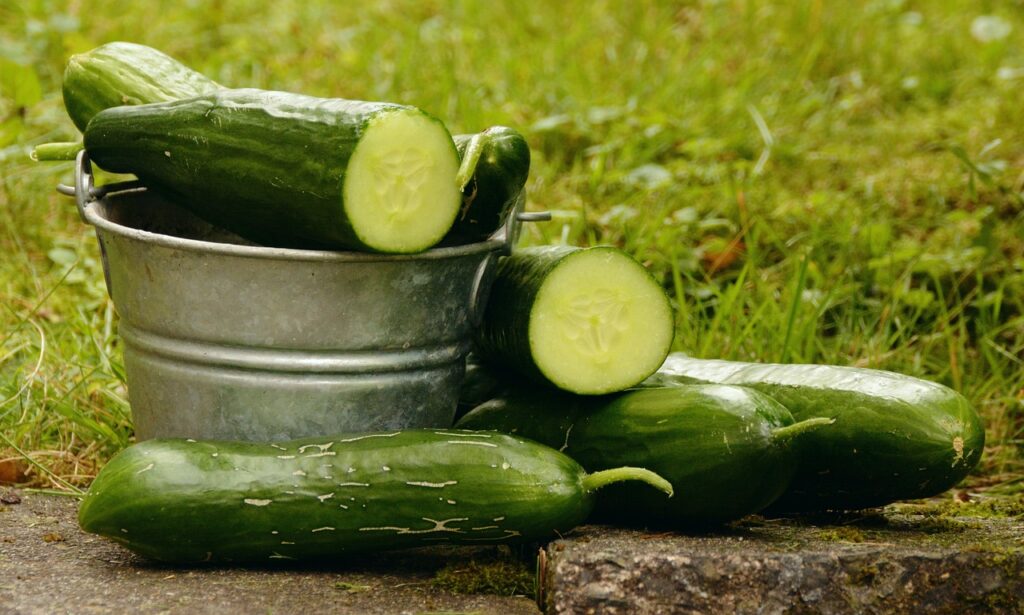
Cucumber
Cucumber is a popular fruit that experts often classify as both a vegetable and a fruit. It is widely cultivated and consumed around the world.
The cucumber has a cylindrical shape with a smooth, green outer skin and a pale, watery flesh with small seeds in the center.
This fruit belongs to the Cucurbitaceae family, which also includes squash and various melon types, such as bitter melon.
Cucumbers are known for their crisp texture and refreshing flavor. They are often eaten raw in salads, sandwiches, and as a garnish for various dishes.
Although cucumbers are low in calories, fat, cholesterol, and sodium, they offer several nutrients.
They are also used to make pickles, which involve soaking them in a brine solution with vinegar, sugar, and spices.
This article will discuss a bit about the nutritional value of cucumbers and their potential health benefits.
It will also touch on ways to consume or use cucumbers and any associated health risks.
Cultivation of Cucumber
People have cultivated cucumbers for over 3,000 years, and their origin can be traced back to India.
Cucumbers have been cultivated in India for food and medicinal uses since ancient times and have been a staple of the Mediterranean diet.
The Greeks or Romans introduced them to Europe, and by the 9th century, they were cultivated in France and, by the 14th century, in England.
North America saw the cultivation of cucumbers by the mid-16th century.
The Roman Emperor Tiberius ensured he had cucumbers available all year by growing them in frames on wheels and cultivating them in cucumber houses.
Charlemagne grew cucumbers in his gardens during the Middle Ages, and reportedly, they were introduced to England in the early 14th century.
During the 17th century, people developed a prejudice against uncooked vegetables, and they gave cucumbers the name cowcumber, believing they were fit only for cows to consume.
Cucumbers are grown in various cultivars, with slicing cucumbers being the most common variety for fresh eating.
Other types include pickling cucumbers, which are used for making pickles, and burpless cucumbers, which are seedless and have a thinner skin.
Types of Cucumber
The hothouse or English cucumber is the most commonly available type, characterized by its large size, dark green skin, and few or no seeds.
Other types of cucumbers, as stated by one source, include the
- Armenian or snake cucumbers,
- Japanese Cucumbers
- Kirby Cucumbers
- Lemon Cucumber
- Persian Cucumbers,
- wild cucumber
Hot House or English Cucumber
Hot House cucumbers, also known as English cucumbers or European cucumbers, can grow up to 60 centimeters in length and have an elongated, thin, and cylindrical shape.
Their outer skin is smooth and furrowed, with a forest green color, while the inner flesh is pale green to translucent white and contains underdeveloped and non-bitter seeds.
These cucumbers are mild and sweet in flavor and have a crisp texture.
They are classified as burpless due to their thinner skins, sweetness, and ease of digestion.
The name “Hot House” comes from the fact that they are grown in greenhouses under controlled environmental conditions with heat and light.
Armenian Or Snake Cucumbers
The Armenian cucumber is also known as the snake cucumber, yard-long cucumber, and cucumber melon.
It closely resembles a cucumber with its long and twisted tubular shape, thin, dark green skin, and pale furrows.
Its skin features deep ridges with light and dark green stripes, creating an attractive display when sliced.
When the fruit is young, its skin may have a slight fuzziness, which can be easily removed.
This unique and unusual variety produces mild-flavored, light green fruits that can grow up to 24–36 inches long. The Armenian cucumber’s best flavor is found at 12–18 inches.
Moreover, its flesh is more similar in texture to a melon and is easily digestible for those who have trouble with other cucumber varieties.
If grown on the ground, the fruits will twist and turn, while they will remain straight when grown on a trellis.
The Armenian cucumber is frequently used for pickling.
Japanese Cucumbers
Japanese cucumbers are a small to medium-sized variety, ranging from 15 to 30 centimeters in length.
They have a narrow and elongated shape with slightly tapered, rounded ends and can appear straight or curved.
The skin’s texture varies depending on the specific variety, ranging from smooth to mildly bumpy or ridged, but it is always edible. The skin is dark green to forest green in color, and people can eat them whole.
Beneath the skin, Japanese cucumbers have a crisp, semi-firm, and aqueous flesh with a succulent nature.
The flesh’s color ranges from white to pale green and contains no developed seeds.
They have a mild, refreshing, sweet, vegetal flavor with subtle green nuances that are reminiscent of melon.
Compared to other cultivars, they have a less bitter taste, making for a more pleasant eating experience.
Kirby Cucumbers
Kirby cucumber has a small size, not exceeding 6 inches in length, and it is known for having firm flesh and a bumpy exterior.
This type of cucumber is crunchy, and it is often used for pickling. Additionally, it can be used in salads and salsa when diced up. The term “Kirby cucumber” is commonly used to refer to pickling cucumbers, although there are other varieties available.
These cucumbers are ideal for pickling because they do not have a waxy outer layer like other cucumbers.
Kirby cucumbers are often used for dill pickles. They have a crispy texture, thin skin, and small seeds.
Lemon Cucumber
Lemon cucumbers, known as Cucumis sativus ‘Lemon,’ have a similar size and color to lemons.
Despite their name, they do not have a citrus flavor and taste like the typical green oblong cucumbers.
The lemon cucumber is about the size of a lemon and has pale skin with a sweet and delicate taste.
They grow on a vine that can reach a height of six to eight feet. Bright yellow blooms appear in the late summer and early fall, followed by round, yellow cucumbers that are about the size of a small tennis ball.
These cucumbers have a mild and sweet taste with a cool and crisp texture, which makes them perfect for salads and pickling.
Persian Cucumbers,
shorter and fatter than hothouse cucumbers and have a crunchy texture when eaten.
Persian cucumbers possess distinctive traits that set them apart from other varieties. Their most notable feature is their size and shape, as they are typically smaller and narrower than the sturdier cucumbers that can grow up to 12 inches or more. They usually reach a length of 4 to 6 inches. Moreover, they are renowned for their tender texture and smooth exterior.
Apart from their size and texture, Persian cucumbers are thin-skinned and contain very few, or no seeds, making them a seedless variety. When it comes to their taste and texture, they have a milder cucumber flavor with a sweet finish, and their flesh is crisp. Unlike other cucumber varieties, they are less water-retentive.
Wild Cucumber
The fast-growing vine, also known as Echinocystis lobata or wild cucumber vine, is native to North America and can quickly grow to lengths of up to 25 feet (7.6 m).
It thrives in moist areas and is commonly found near ponds, streams, or damp meadows or bottomland, but it can also grow in dry areas during periods of above-average rainfall.
Unlike its similarly named relative, this wild cucumber species does not produce any edible fruits with flesh.
Instead, its fruits consist of two chambers that contain seeds and serve solely as seed containers.
While the roots of the plant are edible, they are bitter and unpalatable when eaten raw.
However, boiling the roots can make them into a herbal tea, although it is very bitter and may require sweeteners to improve the taste.
Despite having limited medicinal uses, wild cucumber has been used in folk medicine for centuries.
Boiling the root of the plant can produce an herbal tea believed to alleviate stomach problems, indigestion, nausea, chills, and fevers.
Some researchers also suggest that wild cucumber tea may treat rheumatism and kidney ailments.
Additionally, pulverized roots can be made into a poultice to alleviate headaches and migraines.
The wild cucumber vine, native to North America, is considered a weed by gardeners due to its fast growth. Its fruits are not edible.
Varieties of Cucumbers
Cucumbers are typically categorized into three major cultivar groups in general cultivation: slicing, pickling, and seedless/burpless.
Slicing Cucumbers
Growers cultivate cucumbers for fresh consumption. These types of cucumbers reach maturity on vines with substantial foliage that provides shade.
North American slicers are tough-skinned, longer, smoother, and more evenly colored.
European cucumbers, which are smaller with delicate skin and fewer seeds, are sold in plastic for protection.
They are sometimes called telegraph cucumbers in Australasia.
Pickling Cucumbers
Pickling involves adding brine, sugar, vinegar, and spices to cucumbers and other foods to create various flavors.
Cucumbers specially bred for uniformity of length-to-diameter ratio and lack of voids in the flesh are used in making commercial pickles, although any cucumber can be pickled.
These cucumbers, called picklers, typically grow to about 7 to 10 cm (3 to 4 in) long and 2.5 cm (1 in) wide.
Picklers are shorter, thicker, less uniformly shaped, and have bumpy skin with small white or black-dotted spines compared to slicers. Their color can range from creamy yellow to light or dark green.
Burpless Cucumbers
Burpless cucumbers stand out from other cucumber types for their sweet taste and thin skin.
They offer a delightful flavor and are believed to be easy to digest.
These parthenocarpic cucumbers can grow up to 60 centimeters (2 ft) long, and they have delicate skin with almost no seeds.
They are primarily cultivated in greenhouses and commonly sold in grocery stores wrapped in plastic packaging, marketed as either burpless or seedless.
Some people suggest that the seeds and skin of other cucumber varieties may cause gas.
Nutritional Value of Cucumbers
Cucumbers are low in calories and rich in nutrients, including vitamins C and K, potassium, and antioxidants. They are also high in water content, making them a hydrating food option.
Cucumber, when consumed raw with its peel, consists of 95% water, 4% carbohydrates, and 1% protein. It also contains an insignificant amount of fat.
A standard serving of 100 grams (3.5 ounces) contains 65 kilojoules (16 kilocalories) of food energy.
While the vegetable has low micronutrient content, it is a notable source of vitamin K, providing 16% of the Daily Value.
Aroma and Taste of The Cucumber
The mild melon flavor and aroma of cucumbers vary depending on the type.
This is partly due to unsaturated aldehydes, including (E,Z)-nona-2,6-dienal and the cis- and trans-isomers of 2-nonenal.
Additionally, the rind of the cucumber has a slightly bitter taste because of cucurbitacins.
Risk of Cucumber
Eating cucumbers poses minimal risks, but pesticide use by growers is a concern.
To ensure safety, you can peel off the skin or wash it thoroughly in warm running water before consuming.
Cucumbers have a natural wax coating on their skin, which is removed when washed after picking, and then synthetic wax is added back for better shelf life.
Although the wax itself is not harmful, it can harbor germs. Peeling the skin may reduce contamination risk, but most of the nutrients are found in the skin.
Choosing organic cucumbers and washing them thoroughly can be a better option.
How To Prepare and Store Cucumbers
Before adding cucumbers to your salad, it may be helpful to soak them in salt water. This will help reduce their water content and prevent them from diluting the dressing.
While the skin of the cucumber can be eaten and is a good source of fiber and vitamin A, it is important to wash the cucumber thoroughly beforehand.
Also, avoid those that are yellow, puffy, or have any signs of decay such as sunk-in areas, bulges, or wrinkled ends when selecting cucumbers.
Look for bright, firm, medium- to dark-green, slender cucumbers instead.
Store unpeeled cucumbers in the crisper drawer of your refrigerator, using them within a week if they have a wax coating and sooner if they do not.
Avoid leaving them at room temperature for too long, as this can cause them to become soft and limp.
DISCLAIMER:
The information provided in this article is intended for general informational purposes only and does not take into account your specific circumstances. It should not be considered a substitute for professional medical assistance or advice. You should not rely solely on the information presented in this article when making decisions. Any actions taken based on the information in this article are done so at your own risk and responsibility.





